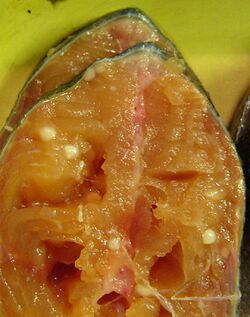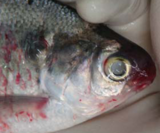Biology:Henneguya zschokkei
| Henneguya zschokkei | |
|---|---|

| |
| Henneguya zschokkei in salmon | |
| Scientific classification | |
| Domain: | Eukaryota |
| Kingdom: | Animalia |
| Phylum: | Cnidaria |
| Class: | Myxosporea |
| Order: | Bivalvulida |
| Family: | Myxobolidae |
| Genus: | Henneguya |
| Species: | H. zschokkei
|
| Binomial name | |
| Henneguya zschokkei (Gurley, 1894)
| |
| Synonyms[1] | |
| |
Henneguya zschokkei is a species of a myxosporean parasite of certain species of salmon of genus Oncorhynchus.[2][3] It causes milky flesh or tapioca disease.[1]
Henneguya salminicola is the first and thus far only known multicellular animal that completely lacks a mitochondrial genome and typical mitochondria, meaning it does not use aerobic respiration to produce energy, but some other, yet unknown, way;[4] it as such does not breathe oxygen.[5]
While eukaryotes are known for their aerobic respiration, a few unicellular lineages that develop in hypoxic environments have lost this capacity. These organisms' mitochondria have lost all or portions of their genomes in the absence of oxygen and developed into mitochondria-related organelles (MROs). The existence of MROs in animals has been a point of contention.[citation needed]
Description
Henneguya salminicola is found in fish as an ovoid spore with two anterior polar capsules and two long caudal appendages.[6] Individuals are 3-6 mm in diameter and can be found at any place in the muscle mass. The parasite is a cnidarian and as such a distant relative of jellyfish.[5]
Hosts
Known hosts of Henneguya zschokkei include:[7]
- Oncorhynchus gorbuscha (Pink salmon)
- Oncorhynchus keta (Chum salmon)
- Oncorhynchus kisutch (Coho salmon)
- Oncorhynchus nerka (Sockeye salmon)
- Anadromous forms of Oncorhynchus mykiss (Rainbow trout)
- Oncorhynchus tshawytscha (Chinook salmon)
- Salmo salar (Atlantic Salmon)
Lack of mitochondrial genome
The anaerobic nature of Henneguya zschokkei was accidentally discovered by scientists at Tel Aviv University, who published their results in February 2020.[4] Professor Dorothee Huchon and colleagues noticed that this animal was missing a mitochondrial genome.[8][9][4]
See also
- Taxa
- Cryptosporidium parvum, a protist without organelle genes
- Mastigamoeba, an anaerobic protist without mitochondria
- Monocercomonoides, a protist without mitochondria
- Loricifera, other metazoans; some species don't require oxygen and may also lack mitochondria
- Structures
- Hydrogenosome, an organelle of some anaerobic taxa
References
- ↑ 1.0 1.1 "Henneguya salminicola". Oregon State University. https://fishpathogens.net/pathogen/henneguya-salminicola.
- ↑ Ward, Henry B. (1919). "Notes on North American Myxosporidia". The Journal of Parasitology 6 (2): 49–64. doi:10.2307/3270895. https://digitalcommons.unl.edu/manterlibrary/22.
- ↑ Greenwood, Veronique (28 February 2020). "This Parasite Doesn't Need Oxygen to Survive - But that's not the weirdest thing about this jellyfish cousin that turns up in the muscles of salmon.". The New York Times. https://www.nytimes.com/2020/02/28/science/parasite-oxygen-mitochondria.html.
- ↑ 4.0 4.1 4.2 Yahalomi, Dayana; Atkinson, Stephen D.; Neuhof, Moran; Chang, E. Sally; Philippe, Hervé; Cartwright, Paulyn; Bartholomew, Jerri L.; Huchon, Dorothée (19 February 2020). "A cnidarian parasite of salmon (Myxozoa: Henneguya) lacks a mitochondrial genome". Proceedings of the National Academy of Sciences 117 (10): 5358–5363. doi:10.1073/pnas.1909907117. PMID 32094163.
- ↑ 5.0 5.1 Brandon Specktor (24 February 2020). "Scientists discover first known animal that doesn't breathe". Live Science. https://www.livescience.com/first-non-breathing-animal.html.
- ↑ Meyers, T. R.; Burton, T.; Bentz, C.; Starkey, N. (July 2008). Common diseases of wild and cultured fishes in Alaska.. Alaska Department of Fish and Game. http://www.north-slope.org/assets/images/uploads/ADFG_2014_fish_disease_book-1.pdf.
- ↑ Buchtová, H.; Dyková, I.; Vršková, D.; Krkoška, L. (2004). "Záchyt lososa masivně infikovaného myxosporidií Henneguya zschokkei" (in cs). Veterinářství 54: 47–48. https://www.vetweb.cz/zachyt-lososa-masivne-infikovaneho-myxosporidii-henneguya-zschokke/.
- ↑ Andrew, Scottie (26 February 2020). "Scientists discovered the first animal that doesn't need oxygen to live. It's changing the definition of what an animal can be". https://www.cnn.com/2020/02/26/world/first-animal-doesnt-breathe-oxygen-scn-trnd/index.html.
- ↑ Shah, Gunjan (27 February 2020). "Scientists discover Henneguya salminicola, a life form that lives without oxygen". India: Republic. https://www.republicworld.com/technology-news/science/scientists-discover-life-form-on-earth-that-lives-without-oxygen.
Further reading
- Lebbad, Marianne; Willcox, Michael (June 1998). "Spores of Henneguya salminicola in Human Stool Specimens". Journal of Clinical Microbiology 36 (6): 1820. doi:10.1128/JCM.36.6.1820-1820.1998. PMID 9620434.
- Fish, Frederic F. (1939). "Observations on Henneguya salminicola Ward, a Myxosporidian Parasitic in Pacific Salmon". The Journal of Parasitology 25 (2): 169–172. doi:10.2307/3272359.
- Clouthier, Sharon C; Gunning, Derek J; Olafson, Robert W; Kay, William W (December 1997). "Antigenic characterization of Henneguya salminicola". Molecular and Biochemical Parasitology 90 (2): 543–548. doi:10.1016/s0166-6851(97)00200-4. PMID 9476801.
- Stojanovski, Stojmir; Spirkoski, Zoran; Hristovski, Miso; Hristovski, Nikola; Blazhekovikj - Dimovska, Dijana (2012). "First finding of parasitic lesions caused by Henneguya zschokkei (Myxosporidia: Myxobolidae) in frozen market salmon in Macedonia". Journal of Hygienic Engineering and Design 1: 139–141. http://eprints.uklo.edu.mk/4759/.
External links
- "Knutsjuka hos laxfisk" (in sv). https://www.sva.se/djurhalsa/djursjukdomar-a-o/knutsjuka-hos-laxfisk/.
- GBIF: Henneguya salminicola Ward, 1919. Id:6881057, source: World Register of Marine Species
- GBIF: Henneguya zschokkei Ward, 1919. Id:6881028, source: Artsnavnebasen
Wikidata ☰ Q16983022 entry


